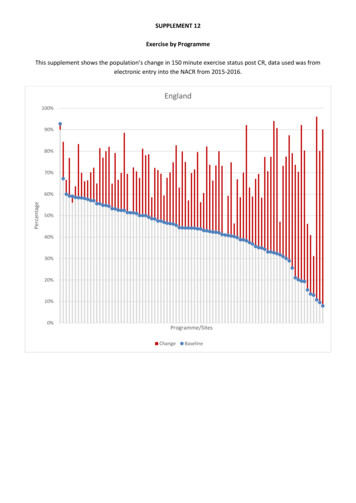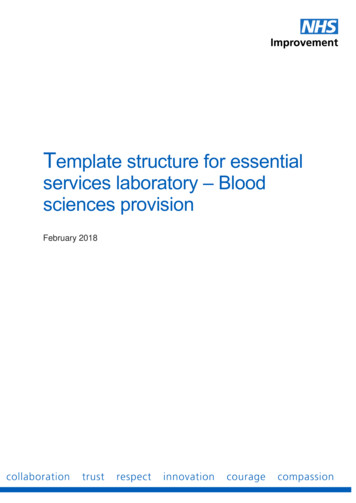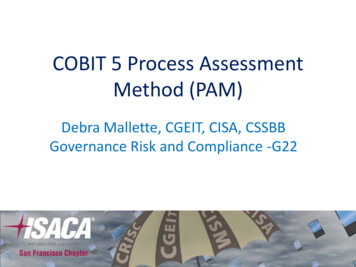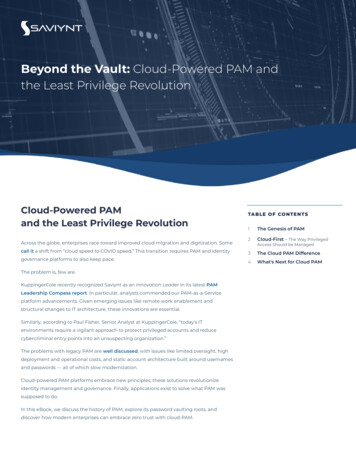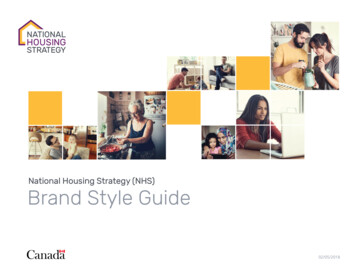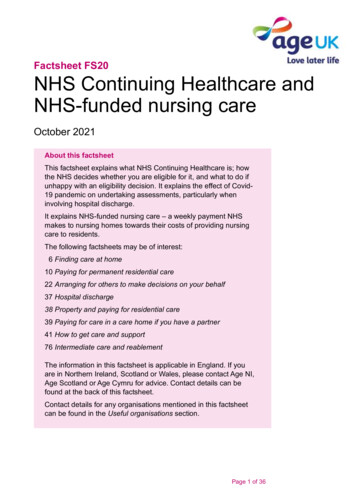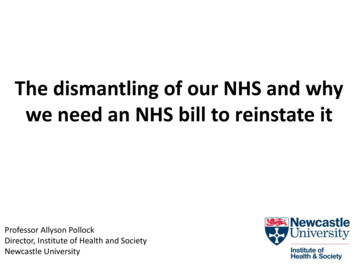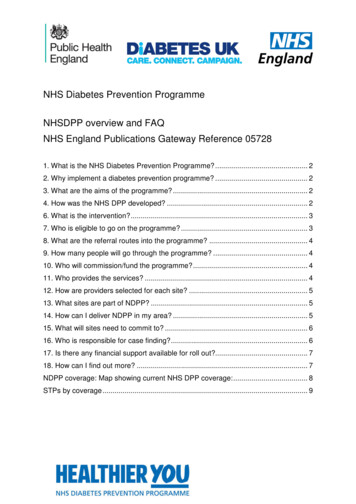
Transcription
1Module 1: PAM implementation quick guide
NHS England INFORMATION READER BOXDirectorateMedicalNursingFinanceOperations and InformationTrans. & Corp. Ops.Publications Gateway Reference:Specialised CommissioningStrategy & Innovation07888Document PurposeGuidanceDocument NamePAM implementation guick guideAuthorNHS England / Personalised Care Group / Patient ActivationPublication Date04 April 2018Target AudienceHealthcare professionals eg in CCGs, providers, STPs and IPC sitesAdditional CirculationList#VALUE!DescriptionThis guide aims to provide practical and operational support toorganisations looking to implement the PAM . It focusses on whypatient activation is important and what organisations need to considerbefore implementation. It should be used in the context of a fullyintegrated approach to personalised care.Cross ReferenceSuperseded Docs(if applicable)Action RequiredTiming / Deadlines(if applicable)Contact Details forfurther informationN/AN/AN/AN/APatient Activation TeamPersonalised Care GroupQuarry House, Quarry HillLeedsLS2 e/patient-activation/licences/Document StatusThis is a controlled document. Whilst this document may be printed, the electronic version posted onthe intranet is the controlled copy. Any printed copies of this document are not controlled. As acontrolled document, this document should not be saved onto local or network drives but shouldalways be accessed from the intranet.
3ForewordPatient Activation: at the heart of personalised careHow do health and care systems support people to develop the knowledge,skills and confidence to manage their health and wellbeing?For nearly 70 years, the NHS has been there for us. It is a constant in our lives, fromcradle to grave. But the NHS was never designed for the 21st century. It was neverdesigned to provide ongoing support for people with long term conditions (LTCs).These people have conditions which can only partly be treated. So, when medicinecan only do so much, what else can or should public services do to support people tolive well despite their medical conditions?We are now beginning to understand that the roots of health lie not in hospitalsor GP surgeries, but in our people and communities. The NHS Five Year ForwardView set out a central ambition for the NHS to become better at helping people tomanage their own health and wellbeing. To meet this commitment, NHS Englandhas been working to scale up support for people living with LTCs. Patient activationis a measure of a person’s knowledge, skills and confidence to manage their ownhealth and wellbeing, and is a core enabler for supporting self-management andpersonalising care.When I first heard about the concept of patient activation, it was a ‘light bulb’moment for me. It has since helped me to understand why some people find itdifficult to engage with managing their long term conditions. I began to tailor whatI was saying to individuals – it was not about telling people what to do, tickingboxes or delivering care; it was about helping them to develop the confidence andunderstanding to allow them to participate more fully in the management of theirhealth and care. This helped to improve their health-related behaviours, and resultedin better outcomes, better experiences of care and fewer episodes of unplanned andemergency care, leading to financial benefits for the healthcare system.If we don’t address the levels of activation in people, there is sufficient evidenceto tell us that they are unlikely to benefit from interventions we provide; they areunlikely to take the medications we prescribe, or even turn up for appointments.We hope that this guide will help you to understand why it is important to focuson people having the knowledge, skills and confidence to manage their health andwellbeing, and how you can use the Patient Activation Measure more effectively. Itwill help you to understand and respond appropriately to the levels of activation ofpeople in your local area, and so help realise the national aspiration for personalisedcare in the NHS.Professor Alf CollinsClinical Advisor, Personalised Care Group, NHS England
4Background to PersonalisedCare and Patient ActivationThis quick guide is an introduction to the use of the Patient Activation Measure PAM which should be used in the context of a fully integrated approach to personalisedcare as set out below.The Next Steps on the Five Year Forward View has brought added impetus tothe need to roll out personalised care across England, to realise the significantcontribution this can make to meet the triple aim of improved health and wellbeing,better care and greater value for the public pound. Demographic and financialpressures, technological advances and changing attitudes require a transformation inthe way we think about health and care. A more proactive, holistic and personalisedapproach, involving greater engagement with people and communities is now theonly sustainable path.Personalised care means people having choice and control over decisions that affecttheir own health and wellbeing within a system that harnesses the expertise, capacityand potential of people, families and communities in delivering better outcomes andreducing health inequalities. It has been defined by people who use health and careservices as “I can plan my care with people who work together to understand me andmy carer(s), allow me control, and bring together services to achieve the outcomesimportant to me.” Personalised care incorporates: A whole population approaches to supporting people of all ages, and theircarers, to manage their physical and mental health and wellbeing and makeinformed choices and decisions when their health changes; A proactive and universal offer of support to people with long term physicaland mental health conditions to build knowledge, skills and confidencethrough supported self-care and community-centred approaches; and Intensive approaches to empowering people with more complex needs tohave greater choice and control over the care they receive.The objective is that in future, people should expect the same focus on theirindependence, the same regard for their wishes and the same opportunities to makechoices and take control, whether they have a long term physical or mental healthcondition, a complex need, or are deciding about particular care or treatment, such asmaternity services or at the end of life.
5The purpose of the Personalised Care Programme is to take the learning to datefrom Integrated Personal Commissioning and the Vanguards programme to scale uppersonalised care to: Improve people’s health and wellbeing outcomes and experience of care,through involving them more fully in designing support around theirindividual needs and circumstances; Prevent crises in people’s lives that lead to unplanned hospital andinstitutional care through supporting effective self-management; Deliver improved value for the health and care system through qualityimprovements, better integration of care and reductions in demand and cost.Making personalised care an everyday reality for people requires the systematicimplementation of a number of evidence-based interventions, involving changesto communities; front line practice; and to commissioning. As well as strongerpartnerships and integration across health, social care and the voluntary, communityand social-enterprise (VCSE) sector and co-production with people with livedexperience. Whilst the ways and means will be diverse and locally distinct, a numberof specific elements will need to be universally adopted to realise the full potential ofpersonalised care: Enabling choice and embedding Shared Decision Making, so that people areinformed and supported as equal partners in decisions about their care andtreatment; Systematic referral to sources of non-clinical support through socialprescribing and community connecting roles, aligned with wider approachesto community capacity building and stronger partnerships with the voluntarysector; Personalised care and support planning as a proactive process, bringingtogether people’s physical, mental health and wellbeing needs into a singleconversation focused on what is important to them and coordinating betteraccess to personalised care and treatment, alongside psychosocial andcommunity based support; Supported self-care tailored to people’s level of knowledge, skills andconfidence, including health coaching, self-management education andsystematic access to peer support options; measured through tools such asthe Patient Activation Measure (PAM ); Integrated personal commissioning, including personal health budgets andintegrated personal budgets; enabling people who could benefit to takedirect control of resources available for their health and care; providing anessential counterbalance to a ‘one-size-fits-all’ commissioning approach, witha greater choice of care and support options.
6People with complex needsIntensive approaches to empoweringpeople, integrating care and reducingunplanned service use.People with long term physicaland mental health conditionsProactive approaches to supporting peopleto build knowledge, skills and confidenceand to better manage their healthconditions.Whole populationUniversal approaches to supportingpeople to stay well and buildingcommunity resilience, enablingpeople to make informed choicesand decisions when their healthchanges.PRIMARY INTERVENTIONS5%(3m)Specialist (Universal and targetedinterventions plus)Integrated personal commissioning including,proactive case finding and personalised care andsupport planning through Multi-DisciplinaryTeams, Personal health budgets & integratedpersonal budgets.30%(16m)Targeted (Universal interventions plus)Proactive case finding and personalisedcare and support planning through GeneralPractice. Self-care support (includinghealth coaching, self-managementeducation and tools such as the PatientActivation Measure).100%(54m)UniversalEnabling Choice (e.g. inmaternity, elective and end oflife care. Shared DecisionMaking. Social prescribing andcommunity connecting roles.Community capacity building.INCREASING COMPLEXITYA flexible system allows for free movement withinthe triangle according to user requirement.TARGET POPULATIONS AND OUTCOMESFigure 1: The Universal Personalised Care ModelThe elements of the whole population approach are illustrated in figure 1.What is Patient Activation?It is now widely acknowledged that people who have the knowledge, confidence andskills to manage their own health tend to have better health outcomes than thosewho have a more passive approach. Patients with high levels of activation understandtheir role in the care process and feel capable of fulfilling that role. Individuals withlong term conditions, who are more highly activated, are more likely to engage inpositive health behaviours and to manage their health conditions more effectively.On the other hand, people who have low levels of activation are less likely to play anactive role in staying healthy. They are less good at seeking help when they need it,at following advice given by healthcare professionals and at managing their healthwhen they are no longer being treated. Their lack of confidence and their experienceof failing to manage their health often means that they may prefer not to thinkabout it.There is also growing evidence that, while individuals may have an underlying levelof ability and inclination to be active in managing their own health, patient activationcan be increased by offering support and providing opportunities to develop bothcondition specific and general health knowledge and skills. The key to self care is anew relationship that puts the needs of the individual first.12Together, these underlying capacities and capabilities are referred to as ‘patient activation’ Hibbard, J. and Gilburt, H. (2014) Supporting people to manage their health: An introduction topatient activation. London: Kings Fund. Available at ield/field publication ation-may14.pdf
7The Patient Activation Measure (PAM )The PAM can make a valuable contribution to assessing a patient’s ability to selfcare at any given time. This assessment helps support next steps on what wouldbe needed to increase their levels of knowledge, skills and confidence in order toimprove their health and wellbeing outcomes. It can be used to tailor interventionsto individual needs, significantly increasing the likelihood that people will adoptbehaviours that contribute to better health. It can also help commissioners to makeavailable the kinds of interventions needed, especially for those with low levels ofactivation who have most to gain.This guide aims to provide some practical and operational support to organisationslooking to implement the PAM . For organisations who are considering usingthe PAM , it will help them to understand why focussing on patient activation isimportant and to think through things they need to consider before they start toimplement it.The content of this guideThis guide has been written based on the experience of a learning set on their use ofPAM , as part of a planned intervention to provide support to people. It draws on thelearning from an independent evaluation of the PAM learning set by the Universityof Leicester, which was jointly funded by NHS England and the Health Foundation toinform the wider implementation of the PAM .Furthermore it reflects experiences of other new users given access to PAM licenceswhich were provided as part of NHS England’s work to support self care . In a shortspace of time, this learning informed NHS England’s decision to make availablea further 1.8 million licences for use by over 60 pioneering health organisationsincluding integrated personal commissioning sites and new care model vanguards.Confidence that healthcare organisations can rise to the challenge of deliveringpeople-centred care has been boosted by the success reported in the Realising theValue programme.The quick guide covers preparatory work, how to ensure good quality data and howthe PAM can ensure that plans for services and support are tailored to an individual’sneeds.The full version of this guide is available from the Patient Activation: Knowledge,Skills and Confidence collaboration es/5 em/login?nextURL %2Fconnect%2Eti%2Fpamn%2F34
8Next stepsSupporting people to have the knowledge, skills and confidence to manage theirhealth and wellbeing should become the normal way of working across the NHS.NHS England is supporting the use of PAM through: Provision of PAM licences to key NHS change programmes and otherorganisations ; the establishment of local networks; the creation of communities of interest through the Future NHS CollaborationPlatform where organisations can share resources and exchange ideas; maintaining a bank of exemplars and case studies; pooling knowledge from evaluations.Additionally, a series of training webinars will be available to sites implementing thePAM to address common challenges, and further individualised support is beingprovided. Further details of these webinars can be found on the Patient ActivationKnowledge, Skills and Confidence collaboration platform.To develop the learning around its implementation, NHS England invites organisationsusing the PAM to share: any issues encountered and how these were solved; materials which have developed that may be useful to others; ideas of the types of support required from NHS England to ensure the correctsupport is provided to local areas to implement PAM effectively; the successes from implementation and how these were celebrated; any suggestions for improvement, and whether or not these have been triedand tested.More information about patient activation is available on the NHS England websiteand the Patient Activation team can be contacted at on/78
9What is the PatientActivation Measure (PAM )?The PAM is a validated, licensed tool that measures people’s knowledge, skills andconfidence (referred to as ‘patient activation’) in managing their own wellbeing. Itis expected that by understanding a patient’s activation level, care can be plannedappropriately with the individual, leading to improved wellbeing and fewer episodesof unplanned and emergency care.The PAM is a validated questionnaire comprising 13 questions and is licensedfrom Insignia Health LLC. The responses match the respondents to one of fourlevels of ‘activation’, each of which reveals insight into a range of health-relatedcharacteristics, including behaviours and outcomes.The PAM should be used in conjunction with care and support planning and a rangeof interventions to support self care.Level 1Level 2Level 3Level 4Disengaged andoverwhelmedBecomingaware, but stillstrugglingTaking actionMaintainingbehaviours andpushing furtherIndividuals arepassive and lackconfidence.Knowledgeis low, goalorientationis weak, andadherence ispoor.Individualshave someknowledge,but large gapsremain. Theybelieve healthis largely out oftheir control, butcan set simplegoals.Individualshave the keyfacts and arebuilding selfmanagementskills. They strivefor best practicebehaviours,and are goalorientated.Individuals haveadopted newbehaviours, butmay struggle intimes of stressor change.Maintaining ahealthy lifestyleis a key focus.Theirperspective:“My doctor isin charge of myhealth”.Theirperspective:“I could bedoing more”.Theirperspective:“I am part ofmy health careteam”.Theirperspective:“I am my ownadvocate”.Increasing level of activationFigure 2: PAM activation characteristics by levelSource: Adapted from Insignia Health PAM practice manual
10Why is knowing the PAM score useful? Services and support can be tailored to ‘meet patients where they are’. Theright intervention can help to increase their knowledge, skills and confidenceand so, improve their ability to look after their wellbeing; Higher activation levels correlate to healthy behaviours, better health outcomesand experiences of care, and fewer episodes of unplanned and emergencycare.Where PAM can support self carePerson-centred care is based around developing a patient-professional relationshipthat seeks to understand and value equally the perspectives of both parties. Theprocess of changing the relationship begins with the initial conversations cliniciansand others have with patients. The initial conversation includes a systematicexploration of the patient’s readiness to begin to take charge of their health. Thisexploration paves the way for the joint creation of an individualised health plan,reflecting the patient’s preferred outcomes and agreed timescales and measures.Some of these measures may be biometric indicators, for instance lowered bloodpressure, while others reflect the patient’s own goals and desired outcomes, forinstance, effective use of public transport to maintain a social life for a patient nolonger able to drive a car. Adding PAM data introduces an evidence based andconsistent measure to help further inform this process.Evidence shows that around 25% of people have the highest level of activation (level4). This indicates there is a lot of scope to improve levels of activation in a population,especially in the lowest levels (levels 1 and 2), where the greatest gains can be made. Services need to target resources at those most in need; at the same time providingmore appropriate support to sustain those who are already actively managing theircondition. During the evaluation of the learning set, staff commented that thosewith higher levels of activation can often benefit from lighter-touch care and that thiswould release time and resources for those at lower levels. However, there were someconcerns that those at lower levels were also the hardest to reach, which meant thatthey were less likely to engage with the PAM .http://www.yearofcare.co.uk/ NHS England have produced resources and guidance for personalised care and support urces-for-ccgs/out-frwrk/dom-2/ltc-care/; and t-participation/patient-centred/planning/12 Collins, A. (2014) Measuring what really matters: Towards a coherent measurement system tosupport person-centred care. London: Health Foundation. Available at ingWhatReallyMatters.pdf13 Hibbard, J. and Gilburt, H. (2014) Supporting people to manage their health: An introduction topatient activation. London: Kings Fund. Available at ield/field publication ation-may14.pdf1011
11Low Complexity High ActivationSupported Self management-online tools, peer networksACTIVATIONWASTE over treatmentHigh Complexity High ActivationLower risk ofProgression butprevention stillimportantCan cope with medicalised coaching GP, Nurse, Become Expert PatientAdd value bysupporting activationLow Complexity Low ActivationEasily missed/isolatedGeneral lifestyle supportVoluntary sector/ CSWHigh Complexity Low ActivationHigh risk ofprogressionpreventionimportantAdd value by buildingawareness of riskEasily overwhelmed protect from over medicalisation.Importance/ Confidence buildingPeer Support, Health trainer,CSW - support medical inputWASTE- patient not readyfor medical interventionMEDICAL COMPLEXITYFigure 3: Dr Ollie Hart, NHS Sheffield CCG at The Kings Fund event, 27 April 2017
12Ten steps towardsimplementing the PAM The PAM is a validated, licensed tool that measures people’s knowledge, skills andconfidence (referred to as ‘patient activation’) in managing their own wellbeing. Itis expected that by understanding a patient’s activation level, care can be plannedappropriately with the individual, leading to improved wellbeing and fewer episodesof unplanned and emergency care.The PAM is a validated questionnaire comprising 13 questions and is licensedfrom Insignia Health LLC. The responses match the respondents to one of fourlevels of ‘activation’, each of which reveals insight into a range of health-relatedcharacteristics, including behaviours and outcomes.The PAM should be used in conjunction with care and support planning and a rangeof interventions to support self care.1Identify need Which patients are we targeting? What improvement in activation levels are we aiming for? What would be the impact if patients had higher levels of knowledge, skillsand confidence? What can we put in place to influence patients’ levels of activation?2Involving people and co-productionWorkforce engagementPatient engagementEngage senior managers and ensurestaff are kept informed and engaged. Aim to provide (as a minimum):People’s understanding of why theyare completing the PAM influenceshow honestly they answer it. Services should provide an informationsheet that covers: a briefing, and question and answer sessions for all the workforceusing the PAM clarity on who is responsible forparticular elements of PAM implementation lists of tasks, with ‘how to’ sheetsfor those who are responsible forparticular actions. what the PAM is, what it does,and how its data will be used who will be targeted and why what the benefits are for patientsand staff how it can improve outcomes forpatients.
133Clarify the reason for its useTo help engage staff and patients, be clear early on about why you arecollecting PAM data, what it measures, and how it can help support patients.Developing a logic model through a workshop engaging stakeholders andpatients may help with this. The process may also alert you to likely sources ofsupport and resistance.4Develop options for supporting self careKnowing a patient’s PAM score can help ensure that care and supportplanning is tailored to the individual. To tailor support, you will need a range ofservices suitable for people at different levels of activation.5Micro-planningTo understand what is required to administer the PAM successfully, it is agood idea to map the processes involved, both from a patient and from thepractitioner’s perspective. It is useful to consider: At what point do we start tailoring for patient need? What options can we offer? How will we know that the chosen option is making a positive difference?People with the lowest levels of activation are likely to benefit most fromservices tailored to their needs.
146Use the process map to identify resources neededTrainingIT integrationOngoing costs Proper staff trainingis essential. As aminimum, twopeople trained inadministering thePAM and withknowledge of thepractice system arerequired. It will vary dependingon the system – theessential requirementis for additionalcoding to allow entryof the PAM scoresinto your IT system. Identify who will takeoverall ownershipof PAM as partof their job plan,even if the scale ofimplementation issmall. Answers to individualquestions in thePAM , as well as theoverall level, formthe basis of thetailoring conversationwith the patient. Staff training toadminister PAM ,and retraining costsin the event of staffturnover. Trained healthcoaches will beneeded if the PAM is being used as atailoring tool. There should besome means ofconnecting PAM scores to a patient’sclinical condition(s),risk scores and arecord of attendanceat the plannedintervention.7 Identify staff to inputdata (and assurequality); and to sendcorrespondence topatients. Costs ofcommissioning andimplementing theintervention(s) butthese can help toachieve financial andwider social benefits.Complete your implementation planUse the information and insight gathered in the previous steps to produce aplan that is viable and supported by other people in your organisation. You canbase your implementation plan on your proposal also, but it should contain: what using PAM well looks like for individuals and staff; a timeline; resources; roles; activities/tasks assigned to specific staff members; monitoring and evaluation arrangements.
158Provide ongoing supportTo get the most out of using the PAM , you will need a support mechanismthat is both general and specific. There will be common needs, but individualsand teams may also experience issues that are unique to them. Practicestend to benefit greatly from sharing experiences and having the opportunityto explore options and share success. You can do this through the PatientActivation: Knowledge, Skills and Confidence collaboration platform.9Plan continuous monitoring and evaluationMonitoring and evaluating the implementation is essential to understand: the delivery of the PAM project (e.g. the efficiency of the delivery model;fidelity to original project plans); the outputs of the PAM project (e.g. the number of licences, patients,practices, sessions delivered); the PAM ’s impact and outcomes (e.g. the effectiveness of the project inachieving desired outcomes).10 Be prepared to support healthcare professionals in theimplementationHealthcare professionals and patients may need support with theimplementation of the PAM . Some concerns for healthcare professionals maybe simply about change in general, but others could be specific to the PAM itself such as a misunderstanding of the concept or its effectiveness.
16Collecting PAM dataStandardise administrationThe way the PAM is administered is known to affect the results and its subsequentusefulness. It is worth investing some time in getting this process right. It is importantthat the process is: Standardised;Routine;Timely;carried out by trained staff; recorded;part of a reliable service;unadulterated;quality controlled.Different methods of administering the PAM There are many ways in which the PAM can be administered but there are somestrong indications on what to do and what not to do. A one-to-one mediated sessionprovides the best chance for patients to fully understand the questions and producethe most consistent responses. This can be done face-to-face or on the telephone. Itprovides an opportunity: for the patient to clarify the PAM ’s purpose or the meaning of questions; for the administrator to provide useful feedback to the patient and to setexpectations about future data collection.Other methods may be in a group situation (e.g. group clinics) or through the post.Further detail is available in Module 3 “Collecting PAM Data” in the full version ofthis guide.Training staffWhatever method is used to administer the PAM , staff must be properly trained.Training should cover: Insignia online training (available at: http://training.insigniahealth.com/login.aspx); how the PAM works and its purpose; the importance of keeping to itswording; how to introduce the PAM ; how to address language and literacy issues; how to respond to a patient’s needs; all of the possible influences on patients completing the questionnaire and theirimpact; how staff can be supported to deliver the PAM within routine workflows.
17Timing and frequency of data collectionInsignia Health recommends that the PAM : should be administered as early as possible in the coaching process; andrepeated every six months. If there are frequent a
7 The Patient Activation Measure (PAM ) The PAM can make a valuable contribution to assessing a patient's ability to self care at any given time. This assessment helps support next steps on what would be needed to increase their levels of knowledge, skills and confidence in order to
